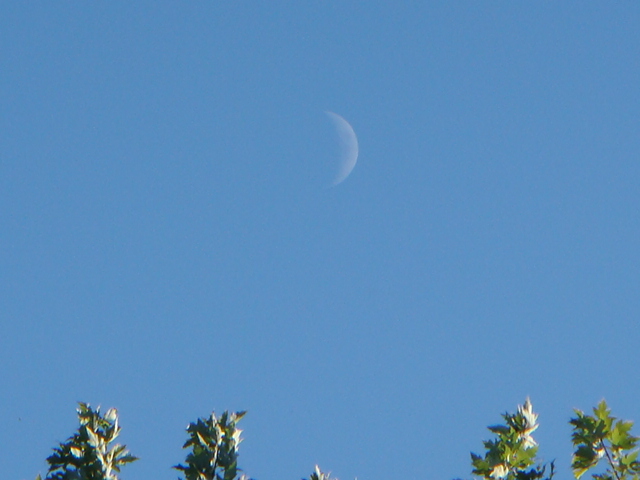Good morning!
We have another day of akibare (autumn clear sky), with beautiful stars this morning and the bright crescent moon last evening. The crisp clear air envelopes all and speckless space penetrates all throughout the universe. When we sit in zazen, we come to a penetrating, pure, serene state, like this autumn sky, cloudless and speckless. Buddhism considers only space and nirvana to be changeless and permanent.
Often we see clouds, sometimes dark ones, with thunderbolts, thunderclaps, tornadoes, or typhoons. All kinds of things take place in that space. But space remains unchanged, penetrating through all things. Such is the state of our original Buddha mind. Buddhas stay in this vast speckless space and see all the changes – the birth and death of clouds – and clearly see how things go and how to deal with them.
Yesterday I talked about Prince Shotoku, the two-year-old figure at the Pulitzer Foundation for the Arts, now exhibiting Buddhist arts. The age is according to traditional counting, so in modern counting he may be a one-year-old, with that baby face. This figure is in gassho, with united hands, and is called Namu-butsu-zo, a “dedication to Buddha” figure – the Buddha of limitless light and life.
The other famous figure traditionally associated with him shows him at sixteen years, or probably fifteen, his coming of age. He wears the okesa, the Buddhist robe. This is called kôyôzô, a figure of filial piety to his sick father, but through him, piety to the Buddha, limitless life and light. By that time Prince Shotoku had already been involved in the battle between the powers that supported Buddhism, and those that opposed it. He became the prince regent of his mother, first empress in Japan, winning the battle.
He put the ranks of officials into order and made the first constitution in Japan (and the world). In this Seventeen Article Constitution, for taking care of people, the first article says, “Harmony is precious.” The Buddha said that friends make all our lives. All religions tell us to become friends (Mitrra, Mithra, Mazda, Maitreya, et al.) with compassion and wisdom, making the true community, Sangha.
The second article says to respect the triple treasure, Buddha, Dharma, and Sangha. The sixth article says that we are all ordinary humans so, therefore, we cannot but rely on the awakened for awakening in truth and building a true community in harmony, not hegemony. We must stop claiming that our limited truth is the absolute one, and fighting like those blind humans that felt an elephant and fought for their limited light and love.
Prince Shotoku was considered a reincarnation of the Buddha and of Avalokiteshvara, the Bodhisattva of Insight and Compassion, Buddha’s epithet. All bodhisattvas strive in the awakened way, are all buddhas, who take the vow to save all beings. Some scholars have doubts about his achievements and even his very existence. But there must be someone who did such wonderful work, creating the constitution and the commentaries on the three scriptures.
The Lotus Sutra advocates one vehicle for the universal salvation of all. The Vimalakîrti Sutra, Purity Fame Scripture, tells of the layman’s teaching of purity even from attachment to petrified purity. The Shômangyô, Supreme Garland Scripture, is about the queen lioness’s roar – fearless, proclaiming the truth. These show his ideals and actions, and allude to his mother, the first empress, who took care of the poor and the sick, even bathing lepers.
Against all the criticism there is substantial evidence in the words preserved in the remnants of the Tenjukoku-shûchô (Heavenly Life Land), an embroidery drapery made by Prince Shotoku’s wife after he passed away, considered to represent the Amitabha (Limitless Life/Light) Buddha’s Pure Land. His words are preserved in the embroidery: “The world is false (empty-provisional); only the Buddha is true.”
Power and pomp, fame and fortune, are false, vain, and void – impermanent in the truth of dependent origination. The Buddha is in truth and peace like limitless space, embracing, illuminating in limitless light and love, liberating all like limitless space in penetrating purity and peace. He realized this through his experience and worked hard for all, as the constitution says, for otherwise even emergencies cannot be dealt with.
The constitutions in our modern world usually claim our rights against other people and nations, justifying killing, etc., and ignoring responsibilities. This constitution has a unique significance for all ages, basing the harmony of community, communication, and compassion on friendship (in nirvana-truth), not fight, much less on greed and hatred based on delusions of me-ism, materialism, and militarism.
All bodhisattvas appear, settle in, and return to nirvana like clouds coming, staying, and returning to the great space – with compassion and awakening, nirvana, where we can attain awakening. There are many bodhisattvas working for truth and peace. Only when we sit, stop our karmas, and see the truth of dependent origination and interdependence can we realize holy (wholly wholesome) harmony, peace, and prognosis.
Even though we appear and disappear, our life is in penetrating peace and purity in limitless light, liberation, and love. In this way we can live on joy, tasting amrita, the ambrosia of immortality, unmoved by birth and death, loss and parting. So, let us continue our practice in this unconditioned peace and unsurpassed awakening, enjoying perfect pure peace and prognosis.
10/2/11

